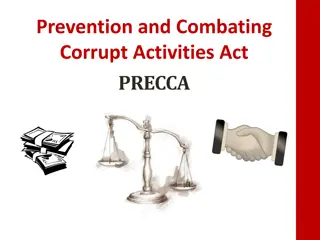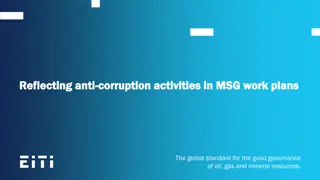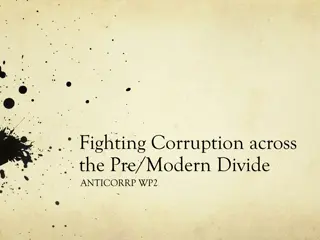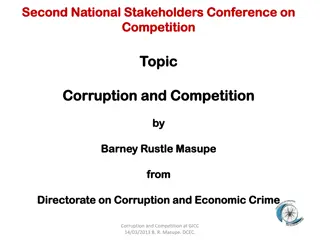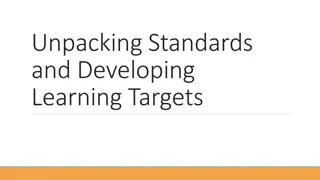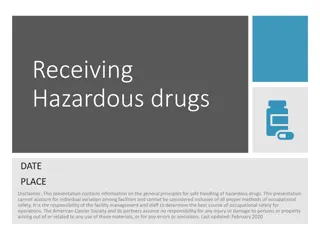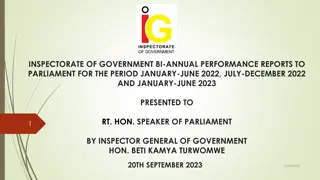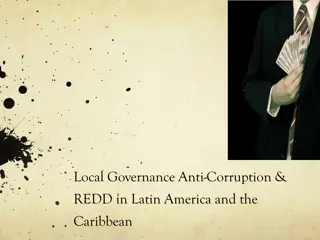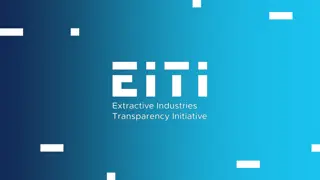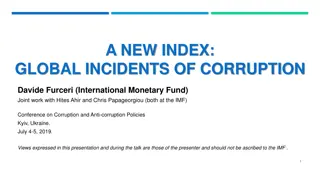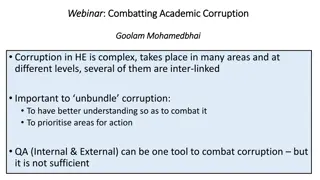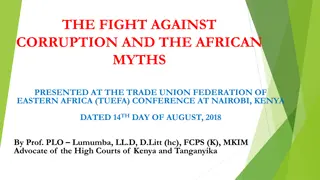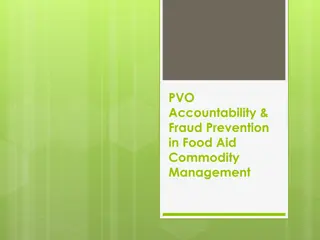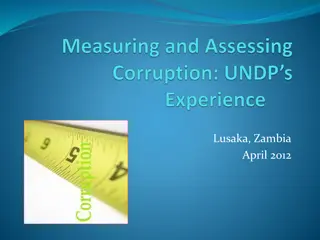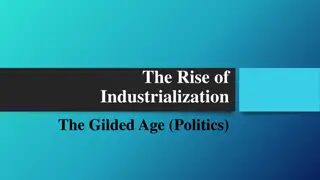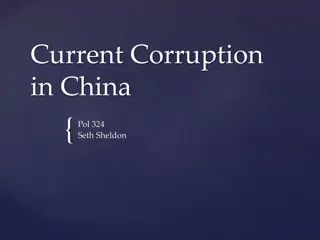Unpacking Self-Reinforcing Corruption Patterns
Delve into the complex dynamics of self-reinforcing corruption cycles and their implications for reform strategies. Explore how widespread corruption weakens deterrence, strengthens individual incentives for corruption, and impacts social norms against corrupt practices.
Download Presentation

Please find below an Image/Link to download the presentation.
The content on the website is provided AS IS for your information and personal use only. It may not be sold, licensed, or shared on other websites without obtaining consent from the author. Download presentation by click this link. If you encounter any issues during the download, it is possible that the publisher has removed the file from their server.
E N D
Presentation Transcript
Corruption as a Self-Reinforcing Trap: Implications for Reform Strategy Matthew C. Stephenson Harvard Law School
Self-Reinforcing Corruption (and Virtuous/Vicious Cycles)
Self-Reinforcing Corruption (and Virtuous/Vicious Cycles) Widespread corruption
Self-Reinforcing Corruption (and Virtuous/Vicious Cycles) Widespread corruption Weaker deterrence
Self-Reinforcing Corruption (and Virtuous/Vicious Cycles) Widespread corruption Stronger individual incentives to engage in corruption Weaker deterrence
Self-Reinforcing Corruption (and Virtuous/Vicious Cycles) Widespread corruption Stronger individual incentives to engage in corruption Weaker deterrence
Self-Reinforcing Corruption (and Virtuous/Vicious Cycles) Low levels of corruption Weaker individual incentives to engage in corruption Stronger deterrence
Self-Reinforcing Corruption (and Virtuous/Vicious Cycles) Widespread corruption Stronger individual incentives to engage in corruption Weaker deterrence
Self-Reinforcing Corruption (and Virtuous/Vicious Cycles) Widespread corruption Stronger individual incentives to engage in corruption Weaker social/moral norms against corruption
Self-Reinforcing Corruption (and Virtuous/Vicious Cycles) Widespread corruption Stronger individual incentives to engage in corruption Selection of corrupt actors into the relevant community
Self-Reinforcing Corruption (and Virtuous/Vicious Cycles) Widespread corruption Stronger individual incentives to engage in corruption Lower per capita income/ Higher economic inequality/ Lower social trust & political engagement
What follows from this? What are the implications for anticorruption strategy?
An influential view: 1. Self-reinforcing corruption implies multiple equilibria: a low-corruption equilibrium and a high-corruption equilibrium trap.
An influential view: 1. Self-reinforcing corruption implies multiple equilibria: a low-corruption equilibrium and a high-corruption equilibrium trap. 2. Because corruption is a self-reinforcing equilibrium, incremental reforms will have little or no effect. The only way to reduce corruption is to tip the system from the high-corruption equilibrium to the low-corruption equilibrium.
An influential view: 1. Self-reinforcing corruption implies multiple equilibria: a low-corruption equilibrium and a high-corruption equilibrium trap. 2. Because corruption is a self-reinforcing equilibrium, incremental reforms will have little or no effect. The only way to reduce corruption is to tip the system from the high-corruption equilibrium to the low-corruption equilibrium. 3. The only way to effect a switch from the high-corruption equilibrium trap to the low-corruption equilibrium is a big bang or big push : changing many things at once, very rapidly.
Paul Collier (Oxford) [An] important implication of the high-corruption trap is that the fight against corruption needs to be a coordinated big push operating on several fronts at once. The society is trapped in what economists would call a locally stable equilibrium: small efforts to reduce corruption will be overcome by the incentives which return the society to its initial pattern of behaviour.
Susan Rose-Ackerman (Yale) If the net rewards of corruption increase as the incidence of corruption increases, then the society may get caught in a trap where high corruption levels beget high corruption levels. In such a situation, a low-corruption equilibrium is unreachable in small steps from the status quo.
Paolo Mauro (IMF) [A]s is often the case with models involving multiple equilibria , gradual reforms are less likely to work than more ambitious, comprehensive reforms.
Bo Rothstein (Gothenburg) When corruption is systemic, following the incremental approach is dysfunctional . [W]hat is needed to establish [a] new equilibrium is a big bang type of change . The implication [of seeing corruption as a self-reinforcing problem] is that taking small steps by installing a few specific institutions is all likelihood a policy in vain.
FIGURE 1:EQUILIBRIUM CORRUPTION (BASELINE CASE) 100% 0% E* 0% 100% % of individuals engaged in corruption
FIGURE 2:SELF-REINFORCING CORRUPTION 100% 0% E* 0% 100% % of individuals engaged in corruption
An influential view: 1. Self-reinforcing corruption implies multiple equilibria: a low-corruption equilibrium and a high-corruption equilibrium trap. 2. Because corruption is a self-reinforcing equilibrium, incremental reforms will have little or no effect. The only way to reduce corruption is to tip the system from the high-corruption equilibrium to the low-corruption equilibrium. 3. The only way to effect a switch from the high-corruption equilibrium trap to the low-corruption equilibrium is a big bang or big push : changing many things at once, very rapidly.
An influential view: 1. Self-reinforcing corruption implies multiple equilibria: a low-corruption equilibrium and a high-corruption equilibrium trap. 2. Because corruption is a self-reinforcing equilibrium, incremental reforms will have little or no effect. The only way to reduce corruption is to tip the system from the high-corruption equilibrium to the low-corruption equilibrium. 3. The only way to effect a switch from the high-corruption equilibrium trap to the low-corruption equilibrium is a big bang or big push : changing many things at once, very rapidly.
FIGURE 4:SHIFTING THE P-ICURVE 100% 0% EH EL 0% 100% % of individuals engaged in corruption
FIGURE 5:EQUILIBRIUM SHIFT WITH SELF-REINFORCING V. NON-SELF-REINFORCING CORRUPTION 100% 0% E1 E0 E2 0% 100% % of individuals engaged in corruption
An influential view: 1. Self-reinforcing corruption implies multiple equilibria: a low-corruption equilibrium and a high-corruption equilibrium trap. 2. Because corruption is a self-reinforcing equilibrium, incremental reforms will have little or no effect. The only way to reduce corruption is to tip the system from the high-corruption equilibrium to the low-corruption equilibrium. 3. The only way to effect a switch from the high-corruption equilibrium trap to the low-corruption equilibrium is a big bang or big push : changing many things at once, very rapidly.
An influential view: 1. Self-reinforcing corruption implies multiple equilibria: a low-corruption equilibrium and a high-corruption equilibrium trap. 2. Because corruption is a self-reinforcing equilibrium, incremental reforms will have little or no effect. The only way to reduce corruption is to tip the system from the high-corruption equilibrium to the low-corruption equilibrium. 3. The only way to effect a switch from the high-corruption equilibrium trap to the low-corruption equilibrium is a big bang or big push : changing many things at once, very rapidly.
FIGURE 6:SELF-REINFORCING CORRUPTION WITH MULTIPLE EQUILIBRIA 100% 0% EH 0% EL EU 100% % of individuals engaged in corruption
An influential view: 1. Self-reinforcing corruption implies multiple equilibria: a low-corruption equilibrium and a high-corruption equilibrium trap. 2. Because corruption is a self-reinforcing equilibrium, incremental reforms will have little or no effect. The only way to reduce corruption is to tip the system from the high-corruption equilibrium to the low-corruption equilibrium. 3. The only way to effect a switch from the high-corruption equilibrium trap to the low-corruption equilibrium is a big bang or big push : changing many things at once, very rapidly.
An influential view: 1. Self-reinforcing corruption implies multiple equilibria: a low-corruption equilibrium and a high-corruption equilibrium trap. 2. Because corruption is a self-reinforcing equilibrium, incremental reforms will have little or no effect. The only way to reduce corruption is to tip the system from the high-corruption equilibrium to the low-corruption equilibrium. 3. The only way to effect a switch from the high-corruption equilibrium trap to the low-corruption equilibrium is a big bang or big push : changing many things at once, very rapidly.
An influential view: 1. Self-reinforcing corruption implies may imply multiple equilibria if other conditions are satisfied: a low-corruption equilibrium and a high- corruption equilibrium trap. 2. Because corruption is a self-reinforcing equilibrium, incremental reforms will have little or no effect. The only way to reduce corruption is to tip the system from the high-corruption equilibrium to the low-corruption equilibrium. 3. The only way to effect a switch from the high-corruption equilibrium trap to the low-corruption equilibrium is a big bang or big push : changing many things at once, very rapidly.
FIGURE 6:SELF-REINFORCING CORRUPTION WITH MULTIPLE EQUILIBRIA 100% 0% EH 0% EL EU 100% % of individuals engaged in corruption
FIGURE 7:MULTIPLE EQUILIBRIA WITH A TEMPORARY CRACKDOWN 100% 0% EH 0% EL EC 100% % of individuals engaged in corruption
FIGURE 8:MULTIPLE EQUILIBRIA WITH INCREMENTAL REFORMS 100% 0% 0% EH-2 EH-1 EL-3 EL-2 EL-1 EH-3 EL-4 100% % of individuals engaged in corruption
An influential view: 1. Self-reinforcing corruption implies may imply multiple equilibria if other conditions are satisfied: a low-corruption equilibrium and a high- corruption equilibrium trap. 2. Because corruption is a self-reinforcing equilibrium, incremental reforms will have little or no effect. The only way to reduce corruption is to tip the system from the high-corruption equilibrium to the low-corruption equilibrium. 3. The only way to effect a switch from the high-corruption equilibrium trap to the low-corruption equilibrium is a big bang or big push : changing many things at once, very rapidly.
An influential view: 1. Self-reinforcing corruption implies may imply multiple equilibria if other conditions are satisfied: a low-corruption equilibrium and a high- corruption equilibrium trap. 2. Because corruption is a self-reinforcing equilibrium, incremental reforms will have little or no effect. The only way to reduce corruption is to tip the system from the high-corruption equilibrium to the low-corruption equilibrium. 3. The only way to effect a switch from the high-corruption equilibrium trap to the low-corruption equilibrium is a big bang or big push : changing many things at once, very rapidly.
An influential view: 1. Self-reinforcing corruption implies may imply multiple equilibria if other conditions are satisfied: a low-corruption equilibrium and a high- corruption equilibrium trap. 2. Because corruption is a self-reinforcing equilibrium, incremental reforms will have little or no effect. The only One way to reduce corruption is may be to tip the system from the high-corruption equilibrium to the low-corruption equilibrium. But incremental reforms can also reduce equilibrium corruption levels. 3. The only way to effect a switch from the high-corruption equilibrium trap to the low-corruption equilibrium is a big bang or big push : changing many things at once, very rapidly.
An influential view: 1. Self-reinforcing corruption implies may imply multiple equilibria if other conditions are satisfied: a low-corruption equilibrium and a high- corruption equilibrium trap. 2. Because corruption is a self-reinforcing equilibrium, incremental reforms will have little or no effect. The only One way to reduce corruption is may be to tip the system from the high-corruption equilibrium to the low-corruption equilibrium. But incremental reforms can also reduce equilibrium corruption levels. 3. The only One way to effect a switch from the high-corruption equilibrium trap to the low-corruption equilibrium is a big bang or big push : changing many things at once, very rapidly. But another way is via the accumulation of a sufficient number of incremental reforms.
Why Should Anyone Care? Sloppy analysis
Why Should Anyone Care? Sloppy analysis Privileging magnitude over sustainability
Why Should Anyone Care? Sloppy analysis Privileging magnitude over sustainability Fatalism/cynicism/complacency
Why Should Anyone Care? Sloppy analysis Privileging magnitude over sustainability Fatalism/cynicism/complacency (Quasi-)authoritarianism




